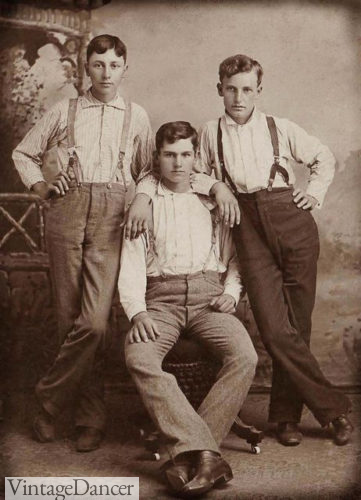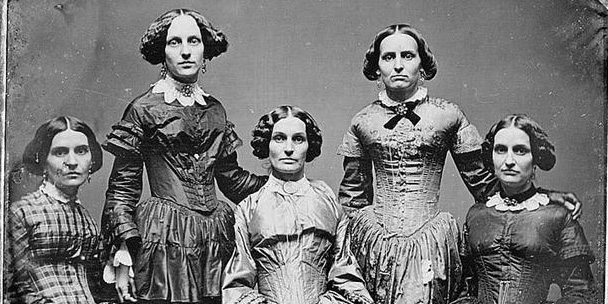A North London street 1950s. At the eve of Industrial change throughout Europe London stood above the other powers.

Working Class Victorian Life Witness2fashion
This flap was universally held in place by two or three buttons at the top.

. Extravagant dandies led the fashion world. Each institution had a system of internal classification that was aided by clothing with some seeing the use of uniforms increase prisons and others seeing it decrease asylums over the 19th century. What was produced in nineteenth-century America as denim work wear for men is in the early 2000s universally available as fashionable leisure wear for men women and children alike and authentic antique jeans command high prices among collectors.
This was the top of the working class pyramid. What was produced in nineteenth-century America as denim work wear for men is in the early 2000s universally available as fashionable leisure wear for men women and children alike and authentic antique jeans command high prices among collectors. Male servants were much more expensive because men were paid much higher wages.
Florence Montgomery Textiles in America 1650-1870 London 2007 Vivian Richmond Clothing the Poor in Nineteenth-Century England New York 2013. The number of individuals and families in these fields exploded in number creating a substantial lower class. In the early 19th century some dandies wore boned corsets to give them a small waist.
The fashion of the 19th century is renowned for its corsets bonnets top hats bustles and petticoats. The main point of this chapter is to emphasise the stigmatising potential of clothing within these institutions. Cutaway Tail Coat 1805-1810.
Summer versions appeared in linen heavy cotton or seersucker. After 1836 the exuberance that had defined fashion since the 1820s collapsed into a drooping sentimentality. 1830-1839 19th century decade overview.
However towards the end of the period the less restrictive Aesthetic style began to emerge. Doc Marten boots had a similar pattern of appropriation and cult status. Research into trousers will also consider issues of materiality as well as uncovering how quickly this new fashion spread amongst the working class.
Tight-fitting pantaloons replaced eighteenth century knee breeches Hessian boots replaced buckled shoes and intricately tied white linen neck cloths became the mark of the true man of fashion. Ad Browse Discover Thousands of Arts Photography Book Titles for Less. TUC Collections London Metropolitan University Womens occupations during the second half of the 19th and early 20th century included work in textiles and clothing factories and workshops as well as in coal and tin mines working in.
The poor working class resided in slums and relied on low wages for basic survival. Feb 18 2022 - Explore Charles Winchesters board Working Class Dress of the Eighteenth Century on Pinterest. 19th Century Urban Working Class.
There was an increase in the middle class during the beginning of the 20th century. A skilled London coach-maker could earn up to five guineas 5 five shillings a week considerably more than most middle class clerks. When history emerged as a scholarly discipline in British universities at the end of the 19th century it rarely took.
In the 19th century the reverse was the case. During the 19th century the lower or working class developed from the groups of 18th century traditional rural peasants and laborers. At first they were only worn for day and informal dress but by the 1820s they were acceptable for evening wear.
Upper class men wore silk or wool broadcloth vests. Today the working class is not looked on by society as something to aspire to be but the whole class did not exist largely before the 19th century and was instead a peasant class existed that performed labor for lords of the land. During the second half of the 19th c men retained the white waistcoat and black tailcoat and trousers of the early 19th c.
In the 19 th-century all women wore several layers of clothing though the clothing got more complicated depending on their socioeconomic status. A tailor or dressmakers profit was often the same as the price of just one yard of the fabric they were making up for their customer. Working Class Movement Library.
Most servants were female. Throughout the century service was a major employer of women. At the same time some new occupations were created which primarily used physical labor rather than mental skills.
Womens fashion during the Victorian period was largely dominated by full skirts which gradually moved to the back of the silhouette. It was at this time in the 19th century that womens clothes in the upper echelons of society came to be more sexualized. In order to be considered middle class you had to have at least one servant.
No belts were worn. For day wear frock coats and straight trousers a short waistcoat and a shirt with a high stiff collar were worn. Trousers became increasingly fashionable in the first quarter of the 19th century.
See more ideas about 18th century 18 century art 18th century clothing. Many had a better standard of living as rural farmers in America or in their native homelands than in industrialized American cities. While clothing was determined by the days activities the basic underclothes or foundational layer for all outfits a chemise drawers stockings corset and petticoats remained fairly consistent.
Working men wore vests of heavy cotton or denim. Wages in the clothing trades varied enormously according to the experience of the worker the size of the firm and the type of clientele for whom they catered. In the late 19th century about 80 of the population of the population was working class.
1830s fashion was dramatic and overwhelming marked by huge sleeves and hats reflecting the Romantic movement. Doc Marten boots had a similar pattern of appropriation and cult status. Short-fronted tailcoats and fitted waistcoats were worn over plain white linen shirts.
The London omnibuses needed 16000 drivers and conductors by 1861. Womens clothing accentuated and exaggerated the hips breasts and derriere not only to make the wearer seem more attractive but to separate these wealthy ladies from the world of work. The railways generated employment for porters and cab-drivers.
By the turn of the 19th century breeches pantaloons and trousers worn by all men were sewn with a flap in front called a fall front. Broadcloth also used for jackets and trousers is a large piece of wool that is felted or shrunk in hot soapy water creating a fabric with no visible weave. Emma Griffin charts the postwar emergence of working-class history as a scholarly discipline and argues that thanks to the torch-bearers the rationale for it has ebbed away.
Gradually men adopted long trousers rather than knee breeches.
History Of The British Working Class Financial Times

Working Class Fashion Late 19th Century Ireland R Historicalcostuming

A Working Class Family Circa 1880 Victorian Life Class Outfit Victorian Clothing

Working Class Jacket 18th Century Fashion 18th Century Costume 18th Century Clothing

1910s Men S Working Class Clothing

Stitching The Fashions Of The 19th Century Who Dressed The 19th Century Elite Historyextra

0 komentar
Posting Komentar